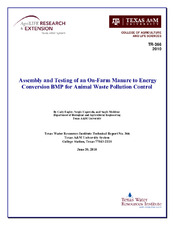| dc.description.abstract | Numerous gasification experiments were conducted and proved that with proper moisture content (usually near 10%) animal manure can be gasified using the TAMU fluidized bed gasifier. In summary the following has been established.
• The heating value of dairy manure on a dry basis was found to be 15.93 + 0.26 MJ/kg (6,863 + 112 Btu/lb), typical of most agricultural biomass. The heating value was around 14.09 MJ/kg (6,070 Btu/lb), on an “as received” basis (around 13% moisture).
• The heating value of synthesis gas from gasification of animal manure was estimated to be around 4.2 MJ/m3 (113 Btu/ft3). This value is very similar to most synthesis gas from agricultural residues.
• Synthesis gas production per unit weight of manure was estimated to be 2.11 m3/kg. The gas production energy efficiency was estimated to be around 55.6% (i.e. 55.6% of the energy was contained in the synthesis gas).
• Char production was on the average around 20% of the feed input. The average heating value of manure char was around 19 MJ/kg (8,816 Btu/lb). Thus, the char energy conversion efficiency was approximately 24% (i.e. 24% of the energy was still contained in the char).
• Twenty percent (20%) of the energy from the biomass was used during the gasification to maintain the temperature of the reactor. Gasification is a continuous, endothermic process and thus, no external fuel is needed other than that used during startup. Natural gas was used during start-up and would last around 30 minutes. After the initial heating of the reactor, part of the biomass materials were used to maintain the operating temperature and the natural gas fuel source was shut off.
• The chemical formula for dairy manure during combustion is shown below. This formula was used only for stoichiometric calculation purposes only.
• Eutectic point analysis of the manure ash showed that the inorganic ash components will start to melt at around 600°C (1112°F). This was established using compressive strength as an indicator of fusion reactions.
• When used for power generation, it was expected to generate at least 25 kW of electrical power output for a 30 cm diameter pilot facility (i.e. at 1.6 tonnes/day (1.8 tons/day)) of feed input. The assumed conversion efficiency was roughly 15% (from synthesis gas to electrical power in a natural gas-type engine-generator). | en |


